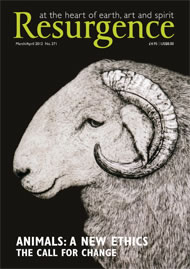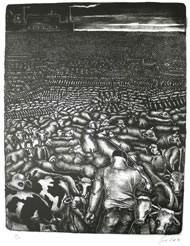A vegan driving a four-track produces fewer greenhouse gases than a meat eater riding a bike! Just as surprising, the car-driving vegan plays a much smaller part in all the Earth’s other escalating environmental catastrophes.
The science behind this has been around for a couple of decades but was marshalled together in 2006 by the UN Food and Agriculture Organization (FAO) in its devastating report Livestock’s Long Shadow. Viva!’s own report Diet of Disaster takes it a step further by including humankind’s failing health, overfishing and global impoverishment.
The simple fact is that livestock production for meat, dairy and leather is now probably the greatest threat to the planet, partly because it takes 17kg of high-quality vegetable protein to produce 1kg of beef protein (meat). It is from this gross inefficiency that many problems arise. And it’s much the same for all meat animals to a lesser degree.
Livestock now demands 70% of all the world’s agricultural land for grazing and fodder growing. There is no spare land remaining, and so, as meat and dairy production expands, valuable ecosystems are destroyed. Of all cleared Amazon rainforest land, 70% is used for grazing and most of the remainder for fodder – particularly soya. Europe encourages the destruction by importing not only meat, but also soya as animal feed (18 million tonnes annually).
Every chicken nugget, slice of bacon, burger and chicken wing helps the destruction of these once-pristine ecosystems.
When the forests go, so does diversity. One thing is certain: the outcome will not be to the benefit of humankind and may eventually prove as devastating to our collective survival as global warming.
On less lush landscapes, such as the semi-arid lands that girdle one third of the Earth, livestock production creates similar problems. Grazing destroys plant life, while heavy bodies and hard hooves break down the soil’s structure. The result is soil degradation, leading inexorably to desertification. Some 72% of these semi-arid lands is now degraded and heading towards becoming desert. As the land dries, what rainfall there is goes elsewhere never to return, making the problem almost eternal.
Both these disasters accelerate global warming as CO2 is released from the soil and from the burning of felled forests. The downward spiral is accelerated by the lack of new forest growth to absorb CO2. And the largest carbon sink of all – soil – ceases to perform its vital role once it becomes degraded.
Livestock’s production of CO2 from machinery and processing, fertilisers for fodder growth, methane from digestion and nitrous oxide from manure makes it the second-biggest source of global-warming gases: 18% of the total, according to the FAO report. It eclipses the 13.5% from all forms of transport – planes, boats, trains and cars. But in fact livestock’s destruction of carbon sinks increases the scale of its contribution to global warming way beyond the 18% headline figure.
The greatest fear of environmental scientists is, perhaps, that global warming will reach a tipping point and begin a process known as ‘positive feedback’. As permafrost begins to thaw, as the seabed of the Arctic Ocean begins to warm, and as organic decomposition takes place in soil, billions of tons of methane will be released. This will accelerate the problem by further increasing global warming – and so on and so on… When might it happen? It might have already begun, but if not it won’t be long, which is why action is needed immediately.
Rapid action is also desperately needed to halt the advance of deadly antibiotic-resistant superbugs, water and air pollution and the overuse of fresh water, all of which have livestock production at their heart. The problems stretch to the oceans, where overfishing has ensured that 82% of species are being fished ‘beyond safe biological limits’ – they are on their way to extinction.
So successfully have we devastated the oceans that fish stocks off our coast are 94% lower than when industrialised fishing began. In 1970, 10% of European fish stocks were overfished; the figure is now 90%. Cod have virtually disappeared, except around Iceland, whilst haddock, plaice, skate, bluefin tuna and sole, along with several other species, are also in crisis.
There is large-scale anarchy at sea, with quotas being ignored because of difficulty in policing the vast areas of hostile water involved. But that isn’t the main reason for the staggering vandalism, the results of which have been predicted for decades. It is politicians and bureaucrats whom we can thank. They have commissioned study after study suggesting what action needs to be taken to stem the collapsing fish numbers and have then immediately ignored them and caved in to the belligerent fishing lobby.
Even if quotas were well policed they would still be a disaster, because many methods of fishing are indiscriminate. A haul of haddock will contain cod but if the quota for cod has been exceeded, every cod in the net has to be thrown back. All die! It is a similar story with other species.
In 2007, EU fisheries commissioner Joe Borg revealed that every year, billions of dead fish are dumped back into the sea – 500,000 to 800,000 tonnes – because they are too small or are in excess of the allowed quota.
Meat, fish and dairy production constitutes the largest industry on Earth, and maintaining this pillar of the economy and the functioning of a free market are both more important to governments than saving the planet or – it seems – us as a species.
Fortunately, the planet has remarkable powers of recovery. Forget politicians! We must persuade the food industry to invest in our, and their, future by providing a vast range of easy-to-prepare, healthy, energy-giving vegan foods that taste better than animal products. Two business incentives are the fact that global-warming weather catastrophes are already very costly to the food industry, and it is in their financial interest to help stop the damage, and that when oil terminally declines, petroleum’s price will spike so high as to bring about the collapse of many parts of today’s economy. Livestock production is exceptionally inefficient, and it has been predicted from within both the livestock and financial sectors that peak oil could bring about its collapse within a few years. The food sector needs to replace animal products with better alternatives now.
As the world relies less and less on farmed animals, pressure on land will reduce, wildernesses will be preserved, environmental and health catastrophes will be headed off, and more jobs will be created in growing and producing safe, healthy foods.
Part of the solution is veganic farming. Like organic farmers, veganic growers don’t use pesticides, synthetic fertilisers or genetically modified crops. But veganic farmers go one step further by avoiding slaughterhouse by-products and animal manure in favour of green manures, mulch, vegetable compost, crop rotation and other techniques that don’t involve the exploitation of animals.
Ultimately, the answer lies with you and me. Thank god, we as individuals don’t need government authority to do the one thing that dwarfs all other green actions – change our diet and stop eating meat, dairy and fish.








